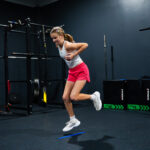Youth Athlete Training Mistakes to Avoid
Youth athlete training can offer tremendous benefits—improved strength, speed, coordination, and confidence. But when done incorrectly, it can lead to frustration, injury, or burnout.
In this article, we’ll highlight the most common training mistakes young athletes make—and how coaches and parents can help prevent them.
Mistake #1: Skipping the Fundamentals
One of the biggest mistakes in youth athlete training is rushing past the basics. Young athletes need to develop proper movement patterns before progressing to advanced exercises.
Skipping this step can cause bad habits, poor posture, and increased injury risk.
Instead, focus on:
-
Bodyweight movements
-
Balance and coordination drills
-
Proper warm-ups and cooldowns
These form the foundation for more intense training later. Mastering the basics first leads to long-term athletic success.
Mistake #2: Training Without a Plan
Some athletes train randomly—doing whatever feels fun that day. While enthusiasm is great, a lack of structure leads to slow or inconsistent progress.
Youth athlete training should follow a plan tailored to age, goals, and sport. A solid program includes:
-
Strength
-
Speed and agility
-
Flexibility
-
Recovery and rest
A well-structured plan keeps athletes motivated and avoids wasted time. Programs like those offered by Next Level Athletics provide the structure and support young athletes need.
Mistake #3: Overtraining
More isn’t always better. Many youth athletes—and even their parents—believe constant training leads to faster results. But this can cause burnout, fatigue, and even long-term injuries.
Signs of overtraining include:
-
Decreased performance
-
Constant soreness or pain
-
Mood changes or irritability
-
Trouble sleeping
The solution? Schedule regular rest days. Balance intense training with low-impact recovery activities. Make sleep, nutrition, and hydration a priority.
Mistake #4: Specializing Too Early
Many parents push their child to specialize in one sport at an early age. While the goal may be to gain a competitive edge, early specialization can backfire.
According to the NSCA, youth athletes who specialize too soon are more likely to suffer overuse injuries and lose interest in sports.
Encourage your athlete to:
-
Play multiple sports
-
Train different movement patterns
-
Develop general athleticism
This balanced approach leads to better performance and reduces injury risk in the long run.
Mistake #5: Ignoring Flexibility and Mobility
Strength and speed get most of the attention—but flexibility and mobility are just as important in youth athlete training.
Neglecting mobility can lead to tight muscles, poor posture, and limited range of motion. That means higher injury risk and lower performance.
Incorporate mobility into each session with:
-
Dynamic warm-ups
-
Static stretches after training
-
Foam rolling and breathing exercises
Make mobility work a habit, not an afterthought.
Mistake #6: Comparing to Other Athletes
Every youth athlete develops at a different pace. Some kids hit growth spurts early; others develop later. Comparing your child to others can lead to discouragement or pressure.
Instead, focus on:
-
Personal progress
-
Effort and consistency
-
Setting and celebrating small goals
When athletes compete with themselves—not others—they build confidence and stay motivated for the long haul.
Mistake #7: Poor Technique Under Load
Lifting weights can be beneficial for young athletes—but only when done with proper form. One of the most dangerous mistakes is adding weight too quickly or using incorrect technique.
Before adding resistance, make sure your athlete can:
-
Perform movements with control
-
Maintain proper alignment
-
Move through a full range of motion
Always prioritize form over load. If in doubt, seek guidance from a trained professional or join a reputable program like Next Level Athletics.
Mistake #8: Failing to Prioritize Nutrition
What young athletes eat directly affects their energy, performance, and recovery. Skipping meals, eating too much junk food, or failing to hydrate are all common mistakes.
Teach your athlete to:
-
Eat balanced meals with protein, carbs, and healthy fats
-
Drink water throughout the day
-
Fuel up before and after workouts
Even small improvements in nutrition can lead to big gains in performance.
Conclusion: Train Smart from the Start
Youth athlete training is a long-term journey. Avoiding these common mistakes helps athletes grow stronger, stay healthy, and reach their full potential.
Focus on fundamentals, balance, recovery, and proper coaching. With smart training and consistent support, your young athlete will thrive—in sports and beyond.


Recent Comments